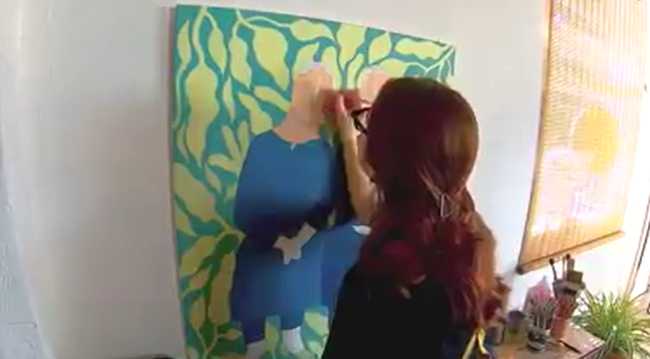DIGITAL

THE MISSING MONUMENT
The Missing Monument is a digital artwork dedicated to the families of persons who went missing during the conflicts of Abkhazia and South Ossetia in the 1990s and 2008.
According to the ICRC’s official data, there are 2’352 persons whose fate and whereabouts are still unknown. The Missing Monument aims at commemorating them but instead of directly recalling the names of the missing ones, this project focuses on the intimate experience of those who stayed behind and are in a permanent state of waiting and missing those who are gone. Beyond this context, the exhibition intends to pay tribute to families from all over the world, whose loved ones have gone missing in other situations, times, and places.
ARTS & CRAFTS

Dolls supporting families in the search for their loved ones
These dolls are just a few centimetres long. You could fit three, five or even ten in the palm of your hand. They are made out of colourful fabrics, paper, twigs and yarn. In some parts of Guatemala, before going to bed, children tell these dolls everything that worries them and keeps them up at night – whatever makes them feel sad and afraid. The dolls take in the children’s worries and help them sleep tight; all they have to do is place the dolls under their pillow (that’s why they are called “worry dolls”, or muñecas quitapenas in Spanish).

Empty Chairs, Waiting Families
“Empty Chairs, Waiting Families” is a memorialization project that started in 2016 as a collaboration between the ICRC, ACT for the Disappeared, and Artichoke Studio. The empty chairs, symbolizing the empty spaces that the missing left behind, were designed and painted by the brothers, sisters, mothers, fathers, wives, daughters, sons, and even grandchildren of people who went missing during armed conflicts since 1975. The sessions of this project helped keep the memory of the missing persons alive by telling their stories and spreading awareness within society about the plight of the families of the missing.
Painting

Women - Syria/Jordan Psychosocial support for Mothers of Missing Persons
In 2022, 30 mothers of missing persons benefited from psychosocial support sessions provided by the International Committee of the Red Cross (ICRC). These sessions contributed to enabling the mothers of missing persons to regain their ability to continue their lives and overcome the “freezing state” from which they were suffering.
In the video, we collaborated with a Syrian artist to paint this painting that expresses psychosocial support sessions.
#InternationalDay of the Missing

State of Disappearance
The initial impetus for this project was conceived back in 2017 as a result of responding to the violence of enforced disappearance, which had become an everyday reality in Chantal's home country of Mexico. As she began her own witnessing to this through art, our subsequent discussions raised a number of crucial questions for us. Not least: how can we do justice to a shattering absence? How could we bring our own grammatical tools to bare on a problem that took us beyond the threshold of intelligibility? What could political philosophy say when confronting the limits of language and what could art say when all presence is being denied?
The exhibition is currently being held at the University of Bath.
FILM
HIVE
Sundance triple award winner HIVE is a searing drama directed by Blerta Basholli based on the true story of Fahrije, who, like many of the other women in her patriarchal village, has lived with fading hope and burgeoning grief since her husband went missing during the war in Kosovo. In order to provide for her struggling family, she pulls the other widows in her community together to launch a business selling a local food product. Together, they find healing and solace in considering a future without their husbands—but their will to begin living independently is met with hostility. The men in the village condemn Fahrije’s efforts to empower herself and the women around her, starting a feud that threatens their newfound sovereignty—and the financial future of Fahrije’s family. Against the backdrop of Eastern Europe’s civil unrest and lingering misogyny, Fahrije and the women of her village join in a struggle to find hope in the face of an uncertain future.
Winner of the Audience Award, Directing Award, and World Cinema Grand Jury Prize at Sundance, HIVE is a pithy, devastating portrait of loss and our uphill journeys to freedom.
Jamale Abou Hamad - جمال أبو حمد | W Biit - وبقيت [Official Video]
To amplify the voices of the missing and honor their stories, our colleagues in Lebanon blended art, culture, and community engagement, Jamale Abou Hamad, a talented communications colleague, created a deeply moving song in tribute to these families. Inspired by her experiences and the stories of the families she has met, Jamale’s song is a heartfelt homage to the missing and their loved ones. It features a soulful dialogue between a wife and her missing husband, walking us through the cherished memories and promises that bind them. This work reflects the emotional weight of the issue and seeks to foster greater awareness and empathy, especially among the younger generation.
#387
On 18 April 2015, a nameless boat sank off the coast of Libya, killing an estimated 800 migrants. It was the worst tragedy in the mediterranean since World War II. The Italian government took the unprecedented decision to surface the wreck and try to identify the victims.
Cristina Cattaneo leads the identification operation. A hoodie, pants, a belt. That’s what’s left of ’Number 387’. From an examination of bones, 3D reconstruction, and cross-checking DNA, Cristina and her team will do everything possible to name each shipwrecked number. In Greece, Pavlos Pavlidis has been working to identify anonymous migrants’ bodies for 17 years. Today, like Cristina, he is one of the representatives of the ICRC for the identification of Mediterranean victims.
In the coming months, they will make every possible effort to name each shipwrecked number. Who are they? Who are we?


